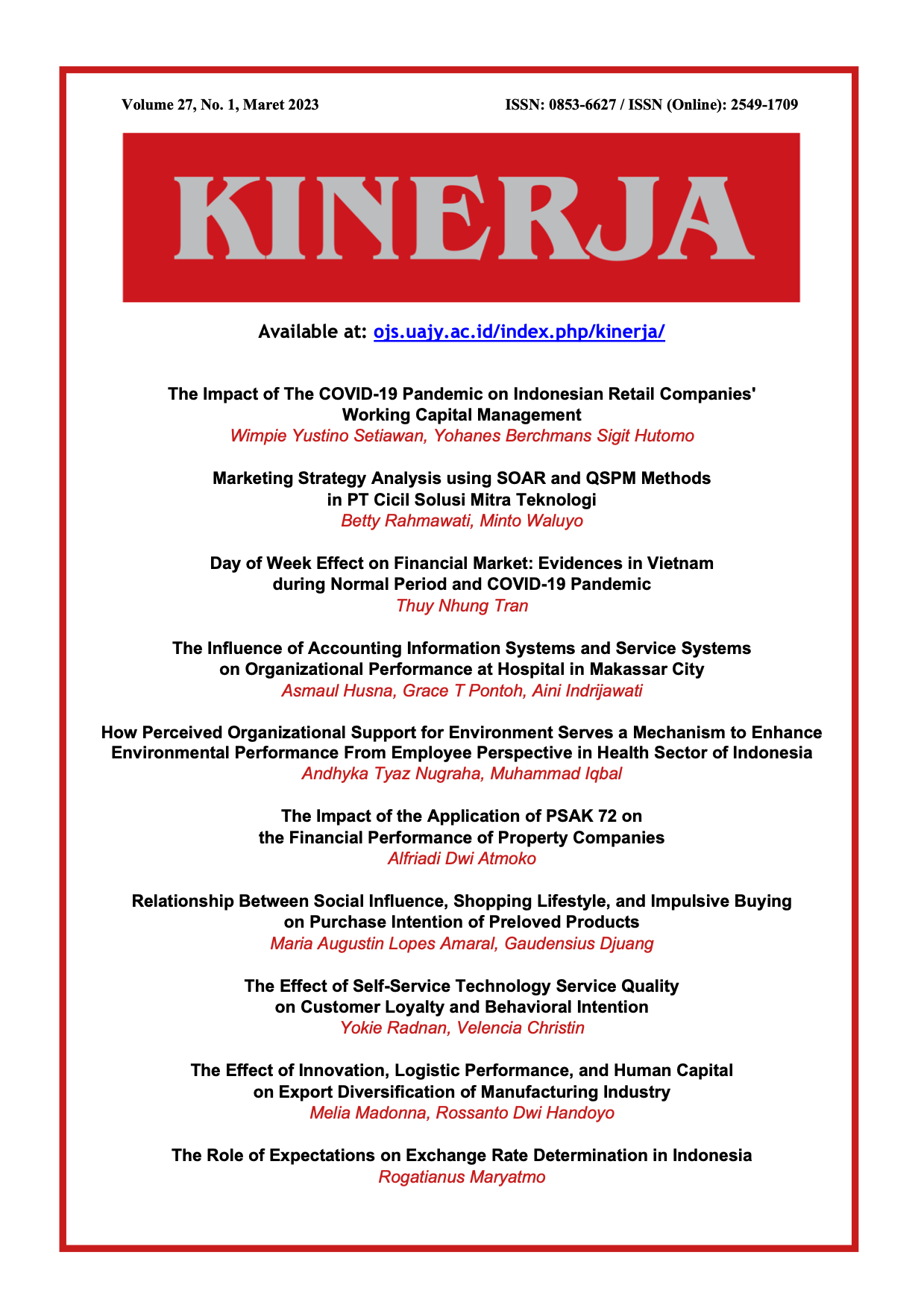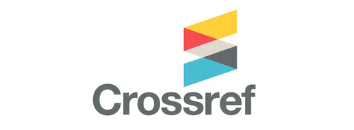Relationship Between Social Influence, Shopping Lifestyle, and Impulsive Buying on Purchase Intention of Preloved Products
DOI:
https://doi.org/10.24002/kinerja.v27i1.6635Keywords:
shopping lifestyle, impulsive buying, intention, social influenceAbstract
This research aims to explain consumer buying behaviour on the Internet in three dimensions: shopping lifestyle, social influence, and unplanned purchases that influence consumer intentions to buy used clothes online on Facebook—conducted this research in the city of Kupang, a sample of 215 respondents. The analytical method used is SEM PLS Version 3.0. The results of this study indicate that shopping lifestyle has a significant effect on purchase intention, social influence have a considerable impact on shopping lifestyle and purchase intention, and impulsive buying substantially impacts purchase intention. Therefore, preloved business people need to consider current lifestyles, social influence and impulsive buying to increase recent preloved buying decisions.
References
Annur, C.M., 2022. Ada 204,7 Juta Pengguna Internet di Indonesia Awal 2022. Databoks, 23 March. Available at: https://databoks.katadata.co.id/datapublish/2022/03/23/ada-2047-juta-pengguna-internet-di-indonesia-awal-2022.
Apupianti, I.N., Sumarwan, U. and Tinaprilla, N., 2019. Influences of shopping lifestyle and reference groups towards purchase intention of preloved fashion. Indonesian Journal of Business and Entrepreneurship, 5(3), pp. 252–262. Available at: https://doi.org/10.17358/ijbe.5.3.252.
Atmaja, N.P.C.D. and Puspitawati, N.M.D., 2019. Strength of reference groups to moderate online repurchase intention on generation X. International Journal of Applied Business and International Management (IJABIM), 4(2), pp.25-32.
Azaruddin, N., 2019. Customer digital shopping orientations and factors of digital shopping behavior in e-retailing shopping among the gen-y students. South East Asia Journal of Contemporary Business, Economics and Law, 20(2), pp. 41–47.
Banytė, J., Rūtelionė, A. and Jarusevičiūtė, A., 2015. Modelling of male shoppers behavior in shopping orientation context. Procedia - Social and Behavioral Sciences, 213(1993), pp. 694–701. doi: 10.1016/j.sbspro.2015.11.489.
Bashir, R., Lodhi, R. N. and Atif, M., 2016. Factor Influencing the purchase intension of consumer while purchasing secondhand products in Pakistan’, Arabian Journal of Business and Management Review. doi: 10.4172/2223-5833.S.
Close, A. G. and Kukar-Kinney, M., 2010. Beyond buying: Motivations behind consumers’ online shopping cart use. Journal of Business Research. Elsevier Inc., 63(9–10), pp. 986–992. doi: 10.1016/j.jbusres.2009.01.022.
Delre, S.A., Jager, W., Bijmolt, T.H. and Janssen, M.A., 2010. Will it spread or not? The effects of social influences and network topology on innovation diffusion. Journal of Product Innovation Management, 27(2), pp.267-282.
Engel, J. F., Blackwell, R. D. and Paul W. Miniard, 1994. Perilaku Konsumen. Enam. Jakarta: Binarupa Aksara.
Ferdinand, A., 2014. Metode Penelitian Manajemen. 5th edition. Semarang: Badan Penerbit Universitas Diponegoro.
Fernandes, S. and Londhe, B. R., 2015. Influence of social reference group on buying behavior, a comparative study of working and non working women in Bangalore - A pilot study analysis. Indian Journal of Science and Technology, 8(March), pp. 95–124. doi: 10.17485/ijst/2015/v8iS6/64720.
Fernandes, S. F. and Panda., R., 2015. Social reference group influence on women buying behaviour: A review. Journal of Commerce and Management Thought, 9(2), p. 273. doi: 10.5958/0976-478x.2018.00019.8.
Fornell, C. and Larcker, D. F., 1981. Structural equation model with unobservable variables measurement error: Algebra and statistics. Journal of Marketing Research, 18(3), pp. 382–388.
Fundrika, B.A. and Rachmawati, D., 2022. Preloved Branded Jadi Tren, Ini Alasan Mengapa Beli Barang Bekas dari Merk Berkelas Tak Perlu Gengsi. Available at: https://www.suara.com/lifestyle/2022/09/29/094500/preloved-branded-jadi-tren-ini-alasan-mengapa-beli-barang-bekas-dari-merk-berkelas-tak-perlu-gengsi (Accessed 6 December 2022).
Gano-an, J.C., 2018. Consumers’ preferences on the use of eco-friendly bags: a green marketing perspective. Journal of Economics, Business & Accountancy Ventura, 20(3). Available at: https://doi.org/10.14414/jebav.v20i3.1104.
Ghouri, A.M., HAQ, M.A.U. and Naveed, R.K., 2017. Customer perception on online purchase intention: The impact of online shopping orientations on online buying intention. The Eurasia Proceedings of Science Technology Engineering and Mathematics, (1), pp.76-82.
Hair, J.F, Anderson, R., Black, B., Babin, B., 2019. Multivariate Data Analysis. 8th edn. United Kingdom: Cenagage.
Hassan, Y., Nik Muhammad, N. M. and Abu Bakar, H., 2010. Influence of shopping orientation and store image on patronage of furniture store. International Journal of Marketing Studies, 2(1), pp. 175–184. doi: 10.5539/ijms.v2n1p175.
Huseynov, F. and Özkan Yıldırım, S., 2019. Online consumer typologies and their shopping behaviors in B2C e-commerce platforms. SAGE Open, 9(2). doi: 10.1177/2158244019854639.
Jamali, K., Samadi, B. and Marthandan, G., 2014. Prioritizing Electronic commerce technologies in Iranian. Interdisciplinary Journal of Contemporary Research in Business, pp. 147–180.
Kim, D. H. and Kim, M. S., 2013. Perception, purchase behaviors of and the buying motives toward secondhand clothing products. The Research Journal of the Costume Culture, 21(3), pp. 324–337. doi: 10.7741/rjcc.2013.21.3.324.
Kim, M. J., Chung, N. and Lee, C. K., 2010. The effect of perceived trust on electronic commerce: Shopping Online for tourism products and services in South Korea. Tourism Management. Elsevier Ltd, 32(2), pp. 256–265. doi: 10.1016/j.tourman.2010.01.011.
Kotler, P and Keller, K. L., 2012. Marketing Management. 14th Edition. New Jersey: Published by Prentice Hall.
Kotler, P., Armstrong, G., Haris, L. C., He, H. 2020. Principles of Marketing. 8th Edition. UK: Pearson.
Kotler, P. and Armstrong, G., 2010. Principle of Marketing, Acta Universitatis Agriculturae et Silviculturae Mendelianae Brunensis. Edited by Upper saddle River. Pearson Prentice Hall.
Kusuma, D. F. and Septarini, B. G., 2013. Pengaruh Orientasi belanja terhadap intensi pembelian produk pakaian secara online pada pengguna online shop. Jurnal Psikologi Industri dan Organisasi, 02(1), pp. 1–10.
Li, N. and Zhang, P., 2002. Consumer online shopping attitudes and behavior: an assessment of research recommended citation consumer online shopping attitudes and behavior: An assessment of research. Americas Conference on Information Systems, 74(3), pp. 508–517. Available at: http://aisel.aisnet.org/amcis2002/74.
Liang, Y., 2012. The Relationship between Consumer Product Involvement , Product Knowledge and Impulsive Buying Behavior. Elsevier B.V., 57(03), pp. 325–330. doi: 10.1016/j.sbspro.2012.09.1193.
Limbad, S., 2015. Study of Women’s Buying Behaviour as Regards Cosmetics in Surat Region India. pp. 137–153. Gujarat: Saraswati Collage of Management.
Ling, K. C., Chai, L. T. and Piew, T. H., 2010. The effects of shopping orientations, online trust and prior online purchase experience toward customers’ online purchase intention. International Business Research, 3(3), p. 63. doi: 10.5539/ibr.v3n3p63.
Meskaran, F., Ismail, Z. and Shanmugam, B., 2013. Online Purchase Intention: Effects of Trust and Security Perception. Australian journal of basic and applied sciences, 7(6), pp. 307–315.
Morgen Shoko, Shoko, J. and Nyoni, T., 2020. The impact of shopping orientation on customer online purchase the impact of shopping orientation on customer online purchase intention in the e- commerce environment in Zimbabwe : Case study of Great. IJARIIE, 6(6).
Mubarak, S. A. and Sanawiri, B., 2018. Pengaruh fashion lifestyle terhadap purchase intention (studi pada konsumen pakaian second hand @tangankedua. Administrasi Bisnis, 55(3), pp. 33–41.
O’Cass, A. and Fenech, T., 2003. Web retailing adoption: Exploring the nature of internet users Web retailing behaviour. Journal of Retailing and Consumer Services, 10(2), pp. 81–94. doi: 10.1016/S0969-6989(02)00004-8.
Park, H.-H. and Choo, T.-G., 2012. Influence of consumer self-confidence and self-confidence in fashion coordination on attitude toward secondhand fashion goods and purchase intention of secondhand fashion goods. Journal of the Korean Society for Clothing Industry, 14(4), pp. 544–553. doi: 10.5805/ksci.2012.14.4.544.
Pebriani, W. V., Sumarwan, U. and Simanjuntak, M., 2018. The Effect of Lifestyle, Perception, Satisfaction, and Preference on The Online Re-purchase Intention. Independent Journal of Management & Production, 9(2), p. 545. doi: 10.14807/ijmp.v9i2.690.
Pena-Garcia, N., Gil-Saura, I. and Rodriguez-Orejuela, A., i Siqueira-Junior, J.R., 2020. Purchase intention and purchase behavior online: A cross-cultural approach. Heliyon, 6(6). doi: 10.1016/j.heliyon.2020.e04284.
Permana, D., 2017. Toward the Best Model of Strategy Implementation in Indonesian Islamic Banking from the Lens of Strategic Clarity. European Research Studies Journal, Volume 20, Issue 4, pp. 3–15.
Preez, R. Du, Visser, E. M. and Zietsman, L., 2007. Profiling male apparel consumers : Lifestyle, shopping orientation, patronage behaviour and shopping mall behaviour. Management Dynamics, 16(1), pp. 2–19.
Rahman, M. A. and Triyonowati, 2022. The influence of reference groups involving emotional marketing on purchase decisions (case study on visitors at Zara store tunjungan plaza Surabaya). International Conference on Business & Social Sciences, pp. 1107–1113.
Rogers, E. M., 2010. Diffusion of Innovations. Know. Innov. Manag. (Fachgebiet Landwirtschaftliche Kommunikations-Und Beratungslehre. doi: 10.1002/chp.4750170109.
Rorong, G. A., Tamengkel, L. F. and Mukuan, D. D. S., 2021. Pengaruh harga dan kualitas produk terhadap keputusan pembelian pakaian bekas import di pasar baru langowan. Productivity, 2(3), pp. 228–233. Available at: https://ejournal.unsrat.ac.id/index.php/productivity/article/view/34769.
Roux, D. and Guiot, D., 2008. Measuring Secondhand Shopping Motives, Antecedents and Consequences. Recherche et Applications en Marketing (English Edition), 23(4), pp. 63–91. doi: 10.1177/205157070802300404.
Salisbury, W., Pearson, R., Pearson, A. and Miller, D., 2001. Identifying barriers that keep shoppers off the world wide web: developing a scale of perceived web security. Industrial Management & Data Systems, 101(4), pp.165-176.
Saputra, Y., 2022. Impor Pakaian Bekas Ilegal: Indonesia “Menjadi Penampung Sampah” Dan Dianggap “Tidak Punya Martabat”’. BBC News Indonesia, 19 September. Available at: https://www.bbc.com/indonesia/articles/c4ndrwez973o.
Schiffman, L. G. and Wisenblit, J., 2015. Consumer Behaviour: Tenth Edition. New Jersey: Pearson.
Schlosser, A. E., White, T. B. and Lloyd, S. M., 2006. Converting web site visitors into buyers: How web site investment increases consumer trusting beliefs and online purchase intentions. Journal of Marketing, 70(2), pp. 133–148. doi: 10.1509/jmkg.70.2.133.
Seock, Y.-K., 2003. Analysis of Clothing Websites for Young Customer Retention Based on A model of Customer Relationship Management Via The Internet. Virginia Polytechnic Institute and State University.
Seock, Y.-K. and Bailey, L. R., 2008. The influence of college students’ shopping orientations and gender differences on online information searches and purchase behaviours. International Journal of Consumer Studies, 32(2), pp. 113–121. doi: 10.1111/j.1470-6431.2007.00647.x.
Sururi, A. and Mulyasih, R., 2017. Penguatan kapasitas masyarakat melalui inovasi formulasi kebijakan perencanaan pembangunan partisipasif di kecamatan wanasalam kabupaten lebak. Wikrama Parahita: Jurnal Pengabdian Masyarakat, 1(1), p. 5. doi: 10.30656/jpmwp.v1i1.267.
Swinyard, W. R. and Smith, S. M., 2003. Why people (don’t) shop online: A lifestyle study of the internet consumer. Psychology and Marketing, 20(7), pp. 567–597. doi: 10.1002/mar.10087.
Thamizhvanan, A. and Xavier, M. J., 2013. Determinants of customers’ online purchase intention: An empirical study in India. Journal of Indian Business Research, 5(1), pp. 17–32. doi: 10.1108/17554191311303367.
Tjokrosaputro, M. and Cokki, C., 2020. The Role of Social Influence Towards Purchase Intention With Value Perception as Mediator: A Study on Starbucks Coffee as an Environmentally Friendly Product. 145(Icebm 2019), pp. 183–189. Available at: https://doi.org/10.2991/aebmr.k.200626.034.
Tuteja, G., Gupta, S. and Garg, V., 2016. Consumer trust in internet shopping. Paradigm, 20(2), pp. 191–215. doi: 10.1177/0971890716670723.
Vijayasarathy, L. R., 2003. Shopping orientations, product types and internet shopping intentions. Electronic Markets, 13(1), pp. 67–79. doi: 10.1080/1019678032000039903.
Wibowo, Y. H., Wijayanto, H. and Daryanto, H. K., 2018. Faktor yang mempengaruhi minat penggunaan perpustakaan digital (studi kasus pada IPB dan UBINUS. Jurnal Aplikasi Manajemen dan Bisnis, 4(3), pp. 431–440.
Yan, R. N., Bae, S. Y. and Xu, H., 2015. Secondhand clothing shopping among college students: The role of psychographic characteristics. Young Consumers, 16(1), pp. 85–98. doi: 10.1108/YC-02-2014-00429.
Zhu, D. S., Lee, Z. C. and O’Neal, G. S., 2011. Mr. risk! please trust me: Trust antecedents that increase online consumer purchase intention. Journal of Internet Banking and Commerce, 16(3), pp. 1–24.















